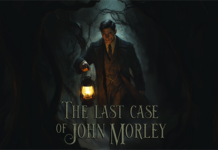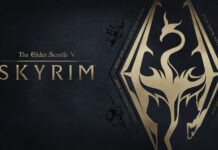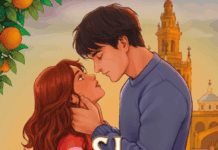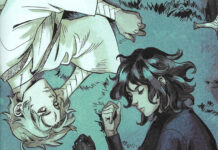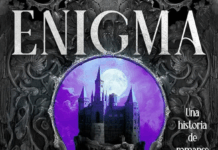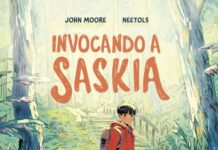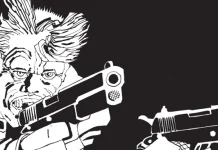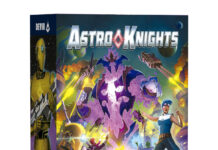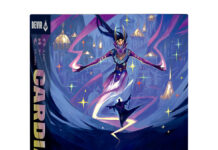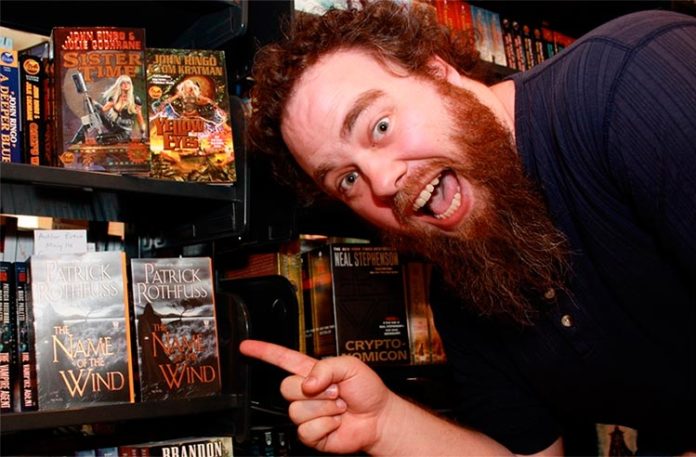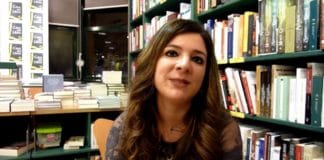(English version of this interview below spanish one) Hace unos días, publicábamos una reseña de un libro fantástico que está sorprendiendo a propios y extraños, no sólo en España, sino en todo el mundo. Hablamos de «The Name of the Wind» («El nombre del viento«), del estadounidense Patrick Rothfuss, publicado en nuestro país por Plaza&Janés.
No sólo Fantasymundo se deshizo en halagos hacia la primera obra publicada de un autor hasta entonces desconocido; la crítica especializada y los lectores en general no han dicho más que maravillas sobre Rothfuss y su prosa realista, sincera y bien urdida, hasta el punto de situarle como una nueva estrella en el firmamento del fantástico, cerca del estilo y profundidad de autores de la talla de J.R.R. Tolkien, George R.R. Martin y Ursula K. Le Guin.
«El nombre del viento» despierta maravilla, empatía y ansias de leer de un tirón las aventuras de su protagonista, Kvothe. En la reseña dejamos claro porque este título nos parece imprescindible para cualquier aficionado a la fantasía, pero más allá de su obra, queríamos conocer a la persona que se esconde detrás de esta gran novela, a la mente capaz de regalarnos esta joya. Rothfuss, muy amable y directo, respondió amablemente a todas nuestras preguntas, evidenciando que para él escribir es una pasión, como lo es para nosotros leer buenas novelas. Os dejamos con la conversación.
Alejandro Serrano: Te has ganado el reconocimiento de los lectores en todo el mundo con tu primera novela, “The Name of the Wind” (“El nombre del viento”), y los críticos te comparan con J.R.R. Tolkien, George R.R. Martin y Ursula K. Le Guin. ¿Cómo te sientes con ello?
Patrick Rothfuss: Estoy terriblemente halagado, por supuesto. Son grandes nombres, crecí leyendo a Tolkien y a Le Guin…
Alejandro Serrano: ¿Estás abrumado por la responsabilidad de continuar escribiendo la saga?
Patrick Rothfuss: Así es, un poco. Durante la mayoría de los últimos dos años he intentado acostumbrarme a mi nueva vida. Estaba contento con ser un estudiante anónimo (y más tarde, un pobre y anónimo profesor universitario). Ahora publico en todo el mundo y todos claman por el segundo libro. Esto representa más presión de la que estoy acostumbrado a sobrellevar, pero creo que finalmente estoy aprendiendo a acostumbrarme a ello.
Alejandro Serrano: Tu editorial española, Plaza&Janés, hizo un gran trabajo con la campaña publicitaria de “The Name of the Wind” (“El nombre del viento”), pero nadie creyó que un autor novel pudiese compararse con los grandes escritores del género. No obstante, los que leyeron el libro se dieron cuenta de que habían tropezado con una joya del género, y comenzaron a hablar sobre “El nombre del viento” como algo de mucho valor, más allá de cualquier campaña publicitaria. ¿Esperaba tener este éxito con su primera novela?
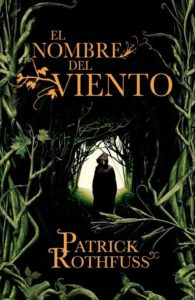 Patrick Rothfuss: Es divertido. Cuando tienes 13 años piensas: “quiero ser autor, ¡porque algún día seré famoso! ¡Publicarán mis libros en todo el mundo, la gente me reconocerá y me pedirá autógrafos!”
Patrick Rothfuss: Es divertido. Cuando tienes 13 años piensas: “quiero ser autor, ¡porque algún día seré famoso! ¡Publicarán mis libros en todo el mundo, la gente me reconocerá y me pedirá autógrafos!”
Pero cuando crecí, me di cuenta de que aquellos sueños eran fantasías de niñez. Los escritores no son estrellas del rock. La mayoría no llegan a ser publicados ni en su propio país, no digamos en el resto del mundo. Y si te publican, probablemente jamás te hagas famoso. La gente ama a los libros, pero no reconoce a los autores por la calle.
Así que entonces, tras haber apartado de mi aquellos estúpidos sueños, me publicaron. Y en todo el mundo. Y la gente me reconocía en la calle y me pedía autógrafos. Sucedió por primera vez en una estación de tren de Manchester cuando me encontraba de vacaciones en el Reino Unido.
Es extraño. Muy extraño.
Alejandro Serrano: ¿Qué esperas que suceda con el segundo, “The Wise Man’s Fear” (“El temor de un hombre sabio”)? ¿Está seguro de que la saga será sólo una trilogía?
Patrick Rothfuss: Sí, lo estoy. Tengo la mayoría de la historia perfilada. Sé exactamente como termina. Exactamente.
Alejandro Serrano: Kvothe es el protagonista indiscutible del primer libro (y probablemente de toda la saga), pero esta no es una novela de un solo personaje. Cada vez que aparece uno en la narración, tratas de dibujarlo lo más real posible, no solo a través de su personalidad, sino de todo su entorno. ¿Cómo te inspiraste para crear a los personajes y su mundo? ¿sabías a donde querías llegar con la historia antes de escribirla o cambiaste muchas cosas en el proceso?
Patrick Rothfuss: Al principio creí saberlo, pero estaba equivocado. He revisado la historia un increíble número de veces a lo largo de los años. Me costó mucho tiempo llegar a donde quería.
Alejandro Serrano: Kvothe estudia en la Universidad, como Harry Potter y Ged. Las peculiaridades de la magia en “The Name of the Wind” (“El nombre del viento”) recuerda a la descrita por Ursula K. Le Guin en “Terramar”, el primer borrador de tu libro se titulaba “The Song of Flame & Thunder” (“Canción de Fuego y Trueno”), muy parecido a “Canción de hielo y fuego”, de George R.R. Martin, y hay otros paralelismos con otros trabajos de algunos autores. Sin embargo, nadie que haya leído el libro puede hablar de plagio… ¿cómo lo explica?
Patrick Rothfuss: Creo que todos tenemos una tendencia natural a establecer comparaciones entre las historias. Desafortunadamente, la mayoría de ellas están basadas en cosas superficiales. Es como decir que “Matrix” y “Tigre y Dragón” son el mismo tipo de película porque en ambas los personajes vuelan a veces. La verdad es que estas películas ni siquiera se parecen.
Creo que ocurre lo mismo con mi libro. Tras un vistazo casual, mi magia y la de Le Guin parecen similares. Ambas utilizan referencias como “nombrar”, así que la conexión parece obvia. Pero los dos tipos de magia no podrían ser más diferentes. La forma en que ella nombra en la magia es muy mecánica, los estudiantes pueden aprenderse listas de nombres. La mía es muy esotérica, los estudiantes pueden aprender… bien… la mayoría del tiempo no aprenden nada sobre nombrar, ya que es algo casi imposible de enseñar. Es casi como intentar enseñar a una persona a sentirse bien con un mandato. ¿Cómo puedes enseñarlo?
Con respecto al antiguo título de la saga, se trata de un ejemplo de evolución convergente. Escogí ese título en 1996. Entonces una amiga me contó que se había leído un libro llamado «Canción de Hielo y Fuego”. Estaba enojado. Nunca me había leído esos libros, pero sabía que tenía que cambiar mi título porque se parecía demasiado.
Alejandro Serrano: La historia engancha a los lectores como pocos libros pueden hacerlo, no solo perfila la historia como si fuese real, también progresa de forma lógica, con giros inesperados. La mejor palabra para definir la historia es “realista”. Kvothe es un artista, un héroe que no desea serlo, la vida le golpea una y otra vez, pero no puede doblegar su espíritu. Tolkien dijo que un héroe no sabe que lo es, simplemente los acontecimientos le llevan a tomar decisiones sin elección. Esto parece sucederle a Kvothe… ¿Quizás por eso le vemos como alguien real y no solo como un personaje?
Patrick Rothfuss: Deseaba escribir una historia realista. El mundo. Los personajes. El diálogo. Las motivaciones y emociones de los personajes. Una buena historia necesita sentirse de forma genuina. Necesita convertirse en verdad. Como si realmente estuviese sucediendo en alguna parte, y sólo mirásemos por la ventana.
Alejandro Serrano: La cubierta de “El nombre del viento” que se publicó en el Reino Unido fue diseñada por Laura Brett, y es la misma que la española. Es una bella ilustración, pero también muy inquietante… ¿Dio instrucciones a la ilustradora, qué le dijo?
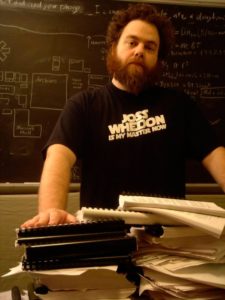 Patrick Rothfuss: No tuve mucho contacto con Laura Brett, intentan mantener a los artistas y los ilustradores separados todo lo que pueden. Por una buena razón, la mayoría de los escritores no son precisamente expertos en grafismo.
Patrick Rothfuss: No tuve mucho contacto con Laura Brett, intentan mantener a los artistas y los ilustradores separados todo lo que pueden. Por una buena razón, la mayoría de los escritores no son precisamente expertos en grafismo.
Es una gran cubierta. Me gusta porque es misteriosa. No creo que se debiese ver la cara de Kvothe en la cubierta. Eso pertenece a la mente del lector. Es mejor si le pones tu propio rostro imaginado, antes de uno impuesto. Es algo más personal. Muy importante.
Alejandro Serrano: Neil Gaiman dijo: “George R.R. Martin is not your bitch” (“George R.R. Martin no es tu zorra”). Algunas veces nos convertimos en fans histéricos mientras esperamos por la continuación de nuestros libros favoritos, y ahora mismo seguro que te presionan para completar la saga cuanto antes. Pero tienes una vida y mucho trabajo. Alguien podría decir “Patrick Rothfuss is not your bitch” o la presión aún no ha sobrecargado tus nervios? ¿Te compadeces de Martin, que ha experimentado esta situación durante años? Ahora mismo casi soy un fan histérico… pero he de preguntarlo, ¿tendremos que esperar mucho? Enviaste el primer borrador a la editorial el mayo (¡3 manojos enormes de folios!), según tu web oficial.
Patrick Rothfuss: Fue más incluso. Más de 1600 páginas.
Me encanta el blog de Gaiman. Me halagó mucho, me mencionó en una entrada.
Martin y yo estamos en el mismo barco. Cuando escribo una entrada en el blog y digo que el segundo libro se retrasa, él me pone un enlace en su propio blog y dice: “Sé exactamente como te sientes, Pat.”
Martin es un santo. Algunos de sus fans le tratan muy mal. Si tuviera que soportar eso durante tanto tiempo, probablemente me habría enfadado mucho…
Alejandro Serrano: Un buen amigo me mandó una fotografía suya con Peter S. Beagle en una convención de los premios Locus. ¿Es uno de tus ídolos? ¿Cómo fue el encuentro? ¿Cuáles son tus referencias literarias?
Patrick Rothfuss: Estaba realmente nervioso. Beagle es uno de mis autores favoritos de siempre, y “El último unicornio” uno de los iconos de la fantasía moderna. Un libro brillante.
Pero encontrarse con él fue muy agradable. Es alguien muy amigable, gentil y elocuente. Muy inteligente también, por supuesto. Puede contar muchas historias sobre el mundo editorial…
Alejandro Serrano: Si te digo la verdad, hay algo que temo que suceda con el segundo libro. No me gustaría que las prisas te afectasen al escribir el segundo y no fuese tan bueno como el primero. Supongo que también ves este peligro… ¿cómo lo evitarás?
Patrick Rothfuss: Afortunadamente, mi editora estadounidense es muy experimentada. Ella quiere el mejor libro posible, y me proporciona el tiempo necesario para escribirlo. Una vez me dijo: «Bajo ciertos puntos de vista, este nivel de éxito es lo peor que le puede suceder a un autor novel. Estoy maravillada de que aún estés escribiendo”.
No me malinterpretes. Está aún ansiosa por que le entregue el libro, como yo lo estoy por entregarlo. Pero es muy cuidadosa y no me mete prisa. Hace un año, Tim Powers me dijo: «Un libro puede llegar tarde sólo una vez, pero puede ser basura para siempre”. Es bueno hacer caso a un profesional como él.
Alejandro Serrano: ¿Tratas de relajarte mientras escribes o revisas el texto?
Patrick Rothfuss: Lo normal, paso bastante tiempo con mi novia. Pasamos el rato y vemos películas. Desconecto. Me entretengo en Facebook. Escribo en los blogs, juego a videojuegos y mantengo extrañas aficiones.
Dejé estas cosas por un tiempo, creyendo que tendría más tiempo para escribir. Pero me hizo más mal que bien. Necesitas divertirte en tu vida para escribir un libro entretenido. No puedes alejarte de todo, alimentarte por un tubo y escribir 16 horas al día.
Alejandro Serrano: Enseñas Inglés y gramática en la Universidad. ¿Tus estudiantes conocen tu libro? ¿qué piensan sobre él? ¿y tu familia?
Patrick Rothfuss: Algunos de mis estudiantes lo conocen. A veces, traen ejemplares para que los firme tras la clase. La mayoría no saben quien soy, o no les importa. Todo sería distinto si enseñase clases de escritura creativa, pero de momento no lo hago.
Alejandro Serrano: ¿Tiene Rothfuss planes sobre nuevos libros tras esta trilogía?
Patrick Rothfuss: Unos pocos. Ahora mismo, tengo una idea sobre un libro sobre niños pero no para ellos, que podría salir a finales de año. Es un pequeño proyecto paralelo que ilustra un amigo, y está saliendo mucho mejor de lo que esperaba. Creo que podríamos situarlo como un cruce entre “Coraline” y “Calvin y Hobbes”, pero es más oscuro. Estoy ilusionado con este proyecto.
Alejandro Serrano: La Semana Negra de Gijón (Asturias, España) es uno de los grandes acontecimientos literarios del país, caracterizado por el contacto directo entre fans y escritores. ¿Le ha contado George R.R. Martin algo sobre ella? ¿Vendría si fuese invitado? Espero que lo haga, algún día…
Patrick Rothfuss: Estaría encantado de ir si me invitan a hacerlo. Me encanta encontrarme con fans y hablar sobre libros. Necesitaría un traductor, desde luego…
Alejandro Serrano: ¿Podría finalizar la entrevista con una frase de Kvothe en “The Wise Man’s Fear”, la segunda parte? Muchas gracias por atendernos, esperemos que los fans no te presionen demasiado, ¡abrazos desde España!
Patrick Rothfuss: Es sorprendentemente sencillo, ahora mismo. No necesito ni abrir el archivo del ordenador porque he revisado mucho el texto últimamente.
Es una parte de un verso que tuve metido en la cabeza. Aquí están las primeras seis líneas:
On his first hand he wore rings of stone,
Iron, Amber, Wood and Bone.
There were rings unseen on his second hand,
One blood in a flowing band,
One was air all whisper thin,
And the ring of ice had a flaw within….
(“En su primera mano llevaba anillos de piedra,
Hierro, Ámbar, Madera y Hueso.
Llevaba anillos invisibles en su segunda mano,
Uno de sangre en una banda que fluía,
Uno era aire que susurraba delicadamente,
Y el anillo de hielo tenía mácula en su interior…“)
Nota del autor de la entrevista y traductor: siento que la versión en castellano no rime, si alguien es capaz de hacer una mejor traducción, estoy abierto a sugerencias…
———————————————————
English version of this Interview:
Alejandro Serrano: You have won the appreciation of readers all around the world with your first novel, The Name of the Wind (“El nombre del viento”), and critics have compared you to J.R.R. Tolkien, George R.R. Martin and Ursula K. Le Guin. How do you feel about it?
Patrick Rothfuss: I’m terribly flattered, of course. Those are huge names. I grew up reading Tolkien and Le Guin….
Alejandro Serrano: Are you overwhelmed by the responsibility of continuing to write your saga?
Patrick Rothfuss: Yeah. A little bit. I’ve spent a lot of the last two years getting used to my new life. I was really good at being a poor obscure college student. (And later a poor, obscure, college lecturer.) Now I’m published all over the world and everyone’s clamoring for book two. It’s more pressure than I’m used to, but I think I’m finally coming to grips with it.
Alejandro Serrano: Your Spanish publishers, Plaza & Janes, made a great campaign in Spain with The Name of the Wind (“El nombre del viento”), but nobody believed that a novice author could compare to the great writers of Fantasy. However, those who have read the book realized that they were faced with a gem of the genre, and began to speak of The Name of the Wind as something valuable beyond any marketing campaign. Did you expect this success with your first novel?
Patrick Rothfuss: It’s funny. When you’re 13 years old, you think to yourself, «I want to be an author, because then someday I’ll be famous! They’ll print my books all over the world! People will recognise me in public and ask for my autograph!»
But then I grew up and realized those dreams were just childish fantasies. Writers aren’t rock stars. Most writers never get published even in their own country, let alone around the world. And if you are published, you’re probably never going to be famous. People love books, but they don’t recognise authors on the street.
Then, after I put those foolish dreams away, I get published. And I am all over the world. And people have recognised me on the street and asked for autographs. It happened in a Manchester train station while I was on vacation in the UK.
It’s strange. Very strange.
Alejandro Serrano: What to expect with next one, The Wise Man’s Fear? Are you sure that the saga will be only a trilogy?
Patrick Rothfuss: Yeah. I’m sure. I’ve got the majority of the story roughed out. I know exactly where it ends. Exactly.
Alejandro Serrano: Kvothe is the undisputed protagonist of the first book (and probably of the entire saga), but this is not a novel of only one character. Every time one appears, you try to draw it as real as possible, not only with their personalities, also their environment. How did you inspired to create the characters and their world, and did you know where you wanted to go with the story before you wrote it, or did a lot of changes in the process?
Patrick Rothfuss: I thought I knew at first, but I was wrong. I’ve revised the story an incredible amount over the years. It took a long time to get everything just right.
Alejandro Serrano: Kvothe studies at the University, such as Harry Potter and Ged. The peculiarities of the magic in The Name of the Wind resembles the magic described by Ursula K. Le Guin in Earthsea, the first draft of your book was entitled The Song of Flame & Thunder, much like A Song of Fire & Ice, by George R.R. Martin, and there are other parallels with works of different authors. However, anyone reading your work can not talk about plagiarism… Can you explain it?
Patrick Rothfuss: I think it’s a natural tendency for people to want to draw comparisons between stories. Unfortunately, most of the time the comparisons are based on superficial things. It’s sort of like saying The Matrix and Crouching Tiger Hidden Dragon are the same sort of movie because they both have a lot of fighting. Truth is, the movies really aren’t anything alike.
I think it’s the same with my book. At a very casual glance, my magic and Le Guin’s seem similar. They’re both referred to as «naming» so the connection seems obvious. But the two types of magic couldn’t be more different. Her naming is very mechanistic, students learn lists of names. Mine is very esoteric, and the students learn… well… a lot of the time they don’t learn anything at all about naming, because it’s a near impossible thing to teach. Like trying to teach a person how to feel joyful on command. How can you teach that?
As for the old title, that’s an example of convergent evolution. I’d chosen that title back in 1996. Then a friend told me she’d read a book called «The Song of Ice and Fire.» I was pissed. I’d never read the books, but I knew I’d need to change mine because it was too close.
Alejandro Serrano: The story hooks the readers as few books can do, you not only draw the story as it was real, also it progresses in a logical way, with unexpected things. The best word to define it is perhaps «realistic». Kvothe is an artist, a hero that doesn’t want to be a hero, life strucks him again and again, but failed to break his spirit. Tolkien said that a hero does not know that he is one, simply events lead him (or her) to choices that sometimes leaves no other choice. This seems to happen with Kvothe… Maybe that’s why we see him as someone real and not just a character?
Patrick Rothfuss: I did want to write a realistic story. For me, everything has to be realistic. The world. The characters. The dialogue. The character’s motivations and emotions. A good story needs to feel genuine. It needs to be true. As if it’s really happening somewhere, and you’re just glimpsing it through a window.
Alejandro Serrano: The U.K. cover of The Name of the Wind was designed by Laura Brett, and it’s the same as the Spanish cover. This illustration is a beautiful one, and also very disturbing… Did you instructed her to draw on? What did you tell her?
Patrick Rothfuss: I didn’t have much interaction with Laura Brett, they try to keep the artists and the illustrators separate as much as possible. For good reason, many authors aren’t terribly graphically savvy.
It is a great cover. I like that it’s mysterious. I don’t think you should see Kvothe’s face on the cover. That belongs in the reader’s mind. It’s better if you see it in your own head, rather than have it handed to you. It’s more personal that way. More important.
Alejandro Serrano: Neil Gaiman said: “George R.R. Martin is not your bitch”. Sometimes we become hysterical fans waiting for the continuity of our favorite books, and surely you are urged right now to complete your saga. But you have a life, and very much work. Someone could say “Patrick Rothfuss is not your bitch” or the pressure is still not overwhelming your nerves? Do you commiserate with Martin, who has experienced this situation for years? I’m almost a hysterical fan now … Will we have to wait long? You sent the first draft in May (3 reams of paper!), according to your website.
Patrick Rothfuss: It was more than three reams of paper, actually. More than 1600 pages.
I loved Gaiman’s blog. I was so flattered, actually that he mentioned me in that one.
Martin and I are in the same boat. When I wrote a blog about the second book being delayed, he put a link up to it on his blog, saying, «I Know Just How You Feel, Pat»
Martin’s a saint, in my opinion. Some of his fans treat him very poorly. If I had to put up with that sort of thing for as long as he has, I probably would have done something very angry by now….
Alejandro Serrano: A good friend sent me a photo of you and Peter S. Beagle in a convention of Locus. Is he one of your idols? How was that encounter? What are your literary references?
Patrick Rothfuss: I was really nervous. Beagle is one of the all-time greats, and The Last Unicorn is one of the cornerstones of modern fantasy. A brilliant book.
But meeting him went relatively smoothly. He’s an incredibly nice guy, so gentle and articulate. Very clever too, of course. He’s got a lot of stories about the publishing world…
Alejandro Serrano: If I tell you the truth, there is something that frightens me with the second part. I would not like rush affects you and the second book wouldn’t be as good as the first one. I guess you also see this danger… How will you avoid this?
Patrick Rothfuss: Luckily, my US editor is very experienced. She wants the best book possible, and is willing to give me time to produce that book. She once said to me, «In some ways, this level of success is the worst thing that can happen to a new author. I’m amazed you’re still writing at all.»
Don’t get me wrong. She’s still eager for the book. As am I. But she’s careful not to rush me. About a year ago, Tim Powers said to me, «A book is late once, but it’s crap forever.» It was good hearing that from a professional like him.
Alejandro Serrano: Do you try to relax while do you write or review the text?
Patrick Rothfuss: Normal stuff. I spend time with my girlfriend. We hang out and watch movies. I goof off online. I play on facebook. I write blogs. I play video games and pursue strange hobbies.
I gave up that stuff for a while, thinking it would give me more time for writing. But it did more harm than good. You need to have joy in your life to write a joyful book. You can’t just trim everything away, get fed through a tube, and write 16 hours a day.
Alejandro Serrano: You teach English language and grammar at University. Do your students know your book? What they think of it? And your family?
Patrick Rothfuss: Some of my students know. Occasionally one brings a book up for me to sign after class. But most of them don’t know who I am, or care. It would be different if I was teaching creative writing classes. But, alas, I’m not.
Alejandro Serrano: Does Patrick Rothfuss have plans about new books beyond this trilogy?
Patrick Rothfuss: A few. I’m actually coming out with a not-for-children children’s book later on this year. It’s a little side project I’ve had a friend illustrate, and it’s turned out so much better than I expected. I think of it as a cross between Coraline and Calvin and Hobbes, but much darker. I’m really excited about that.
Alejandro Serrano: “Semana Negra” in Gijón (Asturias, Spain) is a major literary event in our country, characterized by close contact and respect between the fans and writers. Did George R.R. Martin tell you something about it? Would you come if invited? I hope so, someday…
Patrick Rothfuss: I’d love to come if I was invited. I love meeting fans and talking about books. I’d need a translator though….
Alejandro Serrano: Could you finish the interview with a sentence of Kvothe in The Wise Man’s Fear? Thank you very much to meet us, and I hope that fans will not push you too much, hugs from Spain!
Patrick Rothfuss: That’s surprisingly easy, actually. I don’t even need to open the computer file because I’ve been doing so much revision lately.
It’s a piece of verse I’ve had stuck in my head. Here’s the first six lines:
On his first hand he wore rings of stone,
Iron, Amber, Wood and Bone.
There were rings unseen on his second hand,
One blood in a flowing band,
One was air all whisper thin,
And the ring of ice had a flaw within….

